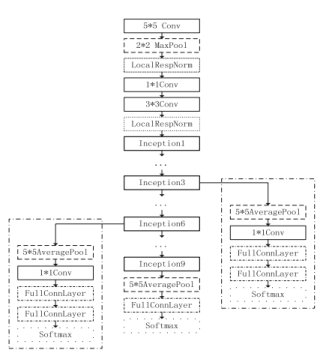请问使用keras如何实现以下网络

问题 1: inception 是不是类似Conv的对象,可以通过这个方式实现
Conv2D(256, kernel_size=(3,3), strides=1, activation='relu', padding='same')
问题 2:inception3 和inception6怎么实现
请问使用keras如何实现以下网络

问题 1: inception 是不是类似Conv的对象,可以通过这个方式实现
Conv2D(256, kernel_size=(3,3), strides=1, activation='relu', padding='same')
问题 2:inception3 和inception6怎么实现
是的,inception可以看作是一种类似于Conv的对象,可以通过Conv2D来实现。在Keras中,可以使用InceptionV3模型中的Inception模块作为基础,通过堆叠不同的Inception模块来构建类似于GoogleNet的网络结构。
以下是一个使用Keras实现基本GoogleNet网络的例子:
from keras.layers import Input, Conv2D, MaxPooling2D, Dropout, concatenate, Flatten, Dense
from keras.models import Model
def inception_module(x, filters):
tower_1 = Conv2D(filters[0], (1,1), padding='same', activation='relu')(x)
tower_1 = Conv2D(filters[1], (3,3), padding='same', activation='relu')(tower_1)
tower_2 = Conv2D(filters[2], (1,1), padding='same', activation='relu')(x)
tower_2 = Conv2D(filters[3], (5,5), padding='same', activation='relu')(tower_2)
tower_3 = MaxPooling2D((3,3), strides=(1,1), padding='same')(x)
tower_3 = Conv2D(filters[4], (1,1), padding='same', activation='relu')(tower_3)
output = concatenate([tower_1, tower_2, tower_3], axis=3)
return output
input_layer = Input(shape=(224, 224, 3))
# stage 1
x = Conv2D(64, (7,7), strides=(2,2), padding='same', activation='relu')(input_layer)
x = MaxPooling2D((3,3), strides=(2,2), padding='same')(x)
x = Dropout(0.2)(x)
# stage 2
x = Conv2D(64, (1,1), strides=(1,1), padding='same', activation='relu')(x)
x = Conv2D(192, (3,3), strides=(1,1), padding='same', activation='relu')(x)
x = MaxPooling2D((3,3), strides=(2,2), padding='same')(x)
x = Dropout(0.2)(x)
# stage 3
x = inception_module(x, [64, 96, 128, 16, 32])
x = inception_module(x, [128, 128, 192, 32, 96])
x = MaxPooling2D((3,3), strides=(2,2), padding='same')(x)
x = Dropout(0.2)(x)
# stage 4
x = inception_module(x, [192, 96, 208, 16, 48])
x = inception_module(x, [160, 112, 224, 24, 64])
x = inception_module(x, [128, 128, 256, 24, 64])
x = inception_module(x, [112, 144, 288, 32, 64])
x = inception_module(x, [256, 160, 320, 32, 128])
x = MaxPooling2D((3,3), strides=(2,2), padding='same')(x)
x = Dropout(0.2)(x)
# stage 5
x = inception_module(x, [256, 160, 320, 32, 128])
x = inception_module(x, [384, 192, 384, 48, 128])
x = MaxPooling2D((7,7), strides=(1,1), padding='same')(x)
x = Dropout(0.2)(x)
# output
x = Flatten()(x)
output_layer = Dense(1000, activation='softmax')(x)
model = Model(inputs=input_layer, outputs=output_layer)
其中,inception_module函数定义了Inception模块的结构,通过堆叠不同的Inception模块来构建GoogleNet网络。在网络的各个阶段,都使用了MaxPooling和Dropout来进行下采样和正则化。最后使用了全连接层进行分类。这里的代码仅供参考,具体的网络结构可以根据需要进行调整。